Have you tried hiking in barefoot shoes? If you’re reading this then maybe you’re considering it, or have already taken baby steps into the world of natural movement (‘freedom for feet’ as I’ve been calling it for decades) and want to know more.
Perhaps your outdoor tribe has started hiking in barefoot shoes but you think it’s a trendy, money-making fad? Or the barefoot hiking boots you recently tested caused foot pain on the trail? And what the heck are the benefits of barefoot shoes anyway?
We’ve got the lowdown on barefoot hiking, the MOVEMENT Movement, and why trying barefoot shoes could be one of the best things you’ll do for your body in a while.
- What does barefoot footwear mean?
- What are barefoot hiking shoes?
- The benefits of barefoot shoes
- The negatives of hiking in barefoot shoes
- Is hiking in barefoot shoes or boots good for you?
- Features of barefoot boots or shoes for hiking
- The best minimalist hiking boots and shoes in 2023
Like many things these days, it is surprising me that it’s taken so long for us humans to realise that it’s simply bad for our species to squash our feet into narrow, cramped, pointed or rigid shoes our whole lives. For decades society has gone along with the accepted norm of what footwear ‘should’ be, despite the fact it makes no sense to damage our bodies with ill-fitting, badly designed apparel.
Fortunately, along with items such as underwired bras and period pants for women, there are innovative people out there looking at how our bodies actually work and what movement and support we consequently need. A new generation of movement-friendly, healthy clothing and footwear is now available to those who care. In this article, we’re talking all things feet.
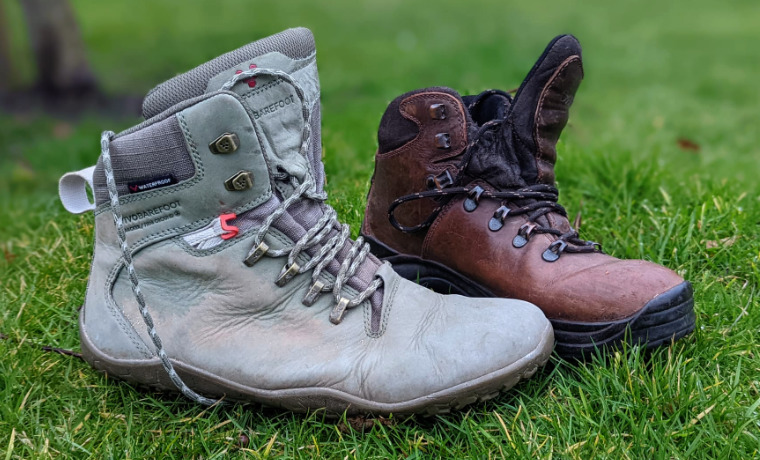
What does barefoot footwear mean?
Barefoot footwear, sometimes called minimalist footwear (and interchangeable for the purpose of this article), is a proper oxymoron although it actually does exactly what it says on the tin.
Thoroughly backed up by science and biomechanics, barefoot footwear basically involves foot-shaped shoe design (wider toe box) and thin, zero or low-drop soles (no rise or lower than standard-rise between toe and heel). This allows for natural body movement while better connecting your feet to the ground, all with comfort, support and sturdiness in mind. It encourages a return-to-nature attitude to life and, for the sceptics among us, it really works for most people.
All very well for everyday shoes (which you can surreptitiously take off if they get uncomfortable), but the question we really want to answer is, are barefoot shoes good for hiking? Will they, and your feet in them, stand up to the pace of long distance, all terrain hiking?
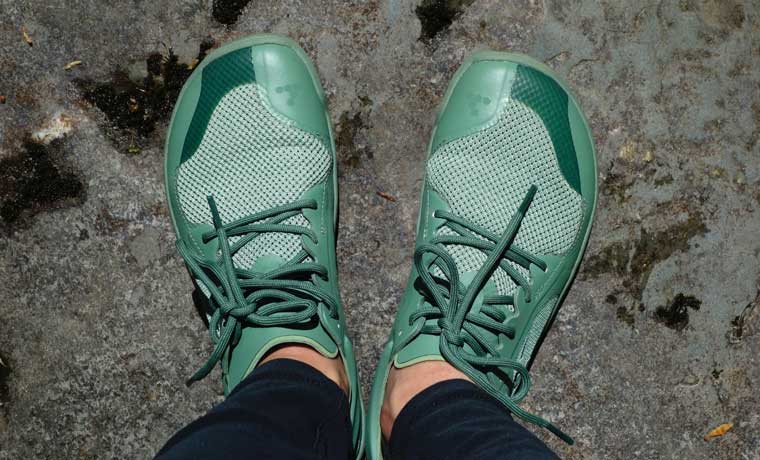
What are barefoot hiking shoes?
All hikers will agree that hiking shoes or boots need to be comfortable, supportive and well worn-in before use on longer expeditions. Barefoot hikers are no different, and as a barefoot walker myself the tech. spec. and design of my boots are of paramount importance.
Minimalist hiking shoes and boots are just like standard hiking shoes and boots in terms of strength, durability and variety but with a few modifications:
- Foot-shaped soles – the wide toe box allows toes to spread and move naturally
- Thin, flexible sole – for extra ground-feel and stability on uneven terrain
- Zero- or low-rise soles – a flat sole with no or little change in height from toe to heel for a more natural, barefoot-like gait
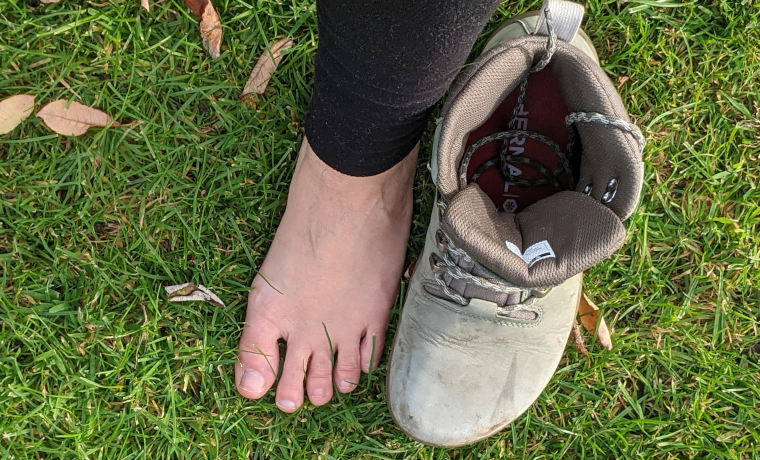
The benefits of barefoot shoes
In today’s sedentary world, with its ‘pandemic of inactivity’, even those of us who are super-outdoorsy often find that our day jobs are behind desks and at computers all day long. We simply don’t move enough.
“Not only do we need to move our whole bodies more; we also need to move our individual body parts more.” says Katy Bowman, biomechanist, author and founder of Nutritious Movement, helping people to move ‘more of our parts more often and more effectively’.
I’ve followed Katy Bowman for some time and her quote above helps to sum up the benefits of choosing barefoot footwear that encourages and allows fuller and more natural movement.
Here are the 4 main ways barefoot hiking shoes and boots can improve our physical wellbeing on the trail:
01Natural movement
Minimalist hiking boots and shoes allow the hiker’s feet to move more naturally within the boot and across the ground. When our toes as well as the bottoms of our feet can properly feel the irregularity of the terrain beneath them, they react by moving, if they are able. This triggers all sorts of further movement throughout the foot, leg and the rest of the body to maintain stability. Of course movement happens in normal hiking footwear but it can be much more restricted if the feet and ankles don’t have the space nor freedom to adjust properly. That’s where those wide toe boxes, foot-shaped soles and less rigid ankles come in.
02Improved ground-feel
Thinner soled-hiking boots or shoes allow our feet to feel the terrain better, improving our brain’s ability to react and adapt our foot and body position for improved movement and balance. The thinner, more flexible soles of minimalist hiking boots give a greater sensation of what is beneath our feet, again allowing our brains and bodies to process more easily and therefore move and adapt more efficiently and naturally.
I love bouldering in the hills and rock pooling at the beach, both activities that I regularly undertake literally barefoot. As soon as my feet are in shoes my balance, stability and reactivity is substantially reduced on such uneven surfaces. Swap normal shoes for my beloved barefoot boots and it’s all back again, anecdotal proof that there is a huge difference in ground-feel between minimalist and normal hiking boots (though I personally prefer the feel of rocks on my actual skin rather than in shoes). My barefoot hiking boots have such flexible soles you can fold them in half!
03Better posture and stronger feet
Foot muscles that we’re not used to using grow stronger in zero drop hiking shoes, allowing our bodies to adjust to the more natural gait, increasing calf musculature, balance and improving overall posture.
As a species we’ve evolved to walk and run with feet that touch the ground at the same level all over, not with a greater height at our heels. Zero drop hiking boots emulate the body’s natural mechanics when upright by allowing our feet to feel the ground at the same elevation over the entire sole, the closest we can get to being actually barefoot while still protecting feet from rugged terrain. In the same way that thinner shoe soles work, zero or low-rise soles improve our ground-feel sensation and subsequent adaptive movement.
04Less weight to carry around
Since most barefoot hiking boots are necessarily made using less materials (thinner sole etc) they are much lighter on the feet. The impact of this has a knock-on effect to the efficiency and speed at which barefoot hiking boots wearers can zoom along the trail. This is especially beneficial over longer distances when even minimal extra weight has a cumulative effect on your body’s effort as the hours pass.
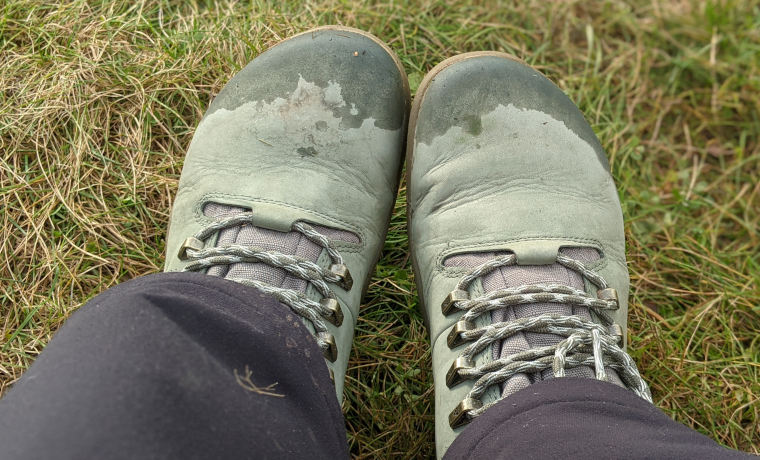
The negatives of hiking in barefoot shoes
Whilst I absolutely love my barefoot boots, they are not for everyone, although I do believe that with a little effort even the most hardened anti-barefooter could get used to them.
Here are a few things to consider when testing a new pair of barefoot shoes:
Aches and pains while you transition
How quickly you adapt to barefoot hiking boots is mainly down to your own physiology, and that is largely down to the amount of actual barefoot walking (with no shoes at all) that you do/have done in the past. As mentioned, I’ve spent most of my life shoeless, so for me, discovering barefoot hiking boots was an absolute freedom and relief. I had no issues changing from rigid to barefoot boots at all.
If you haven’t used barefoot hiking shoes before you’ll need to spend a lot more time breaking them in than normal boots. This is because you’re breaking in your body as much as the actual boots. If not you’ll feel tired and stiff more quickly and will be more prone to injury until your body has adjusted.
Most newbie barefoot hikers experience calf pain until their muscles have adapted to the new way of moving. So a very gradual conditioning is recommended before attempting any major distance.
A couple of trail runners I know who have swapped successfully to barefoot running shoes found they experienced Achilles pain for a time as well. The majority of hikers will be able to get beyond these setbacks with gradual and gentle easing in. Then you’ll be off on a whole new journey of movement and balance.
Soft uppers can crease
Given the flexible nature of a barefoot hiking shoe or boot, which needs to be able to move and flex as the sole of the shoe moves and flexes, the uppers are usually made from softer materials than standard hiking boots. In my experience this leads to creasing over the toe box, which is something not seen in standard boots until they have had much more wear.
It doesn’t bother me; it’s the pay off for having greater comfort and natural movement in my entire body. But it means that some styles may potentially crack in these areas thus affecting support and waterproofing. It’s something I’ll be keeping an eye on in the genre as barefoot walking and hiking becomes more popular and worth considering if you do lots of wet, snowy hikes. Summer hikers won’t need to worry!

Other things to consider when buying barefoot boots or shoes
Size difference
Be aware that your new barefoot hiking boots or shoes may not be your usual size. This is due to the wider, flexible design. So it’s well worth researching with individual companies as to their recommendations for the correct fit based on your current shoe size.
Vivobarefoot has an excellent online shoe size app using your smartphone camera which is spot on. I used it but ignored the advice and, lo and behold, had to return and request the next size up. They’re the experts after all, what was I thinking?
Cold feet consideration
When shopping around for a new pair of barefoot boots, it’s worth bearing in mind that the thinner soles of barefoot shoes mean there is less insulation between you and the earth. Not so great in cold, wet, winter weather. Many manufacturers combat this with removable thermal insoles in all-season boots and shoes. I would highly recommend this option if you intend to do lots of cool weather hiking. My thermal insoles are epic, though watch out for a hot foot panic if you forget to take them out in hot weather!
Socks!
It’s worth noting that the type of socks you wear can affect the freedom of movement of your feet. Tight-fitting socks, though nowhere near as restrictive as regular shoes or boots, don’t let your toes splay in the way that your barefoot hiking boots encourage them to. To get the full benefit of that spacious toe-box, ensure that you wear socks that aren’t too tight and that have a wider than average toe area. Thorlos Socks tend to have extra width at the toe.
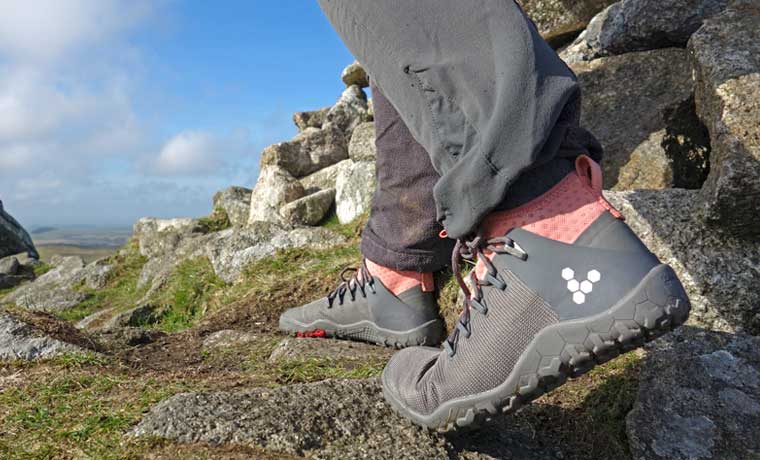
Is hiking in barefoot shoes or boots good for you?
A subjective question perhaps? There are those who love the freedom, comfort and body benefits of barefoot hiking and will never return to standard boots. There are also those who can’t stand it (possibly because they didn’t take the time to recondition their muscles and transition properly). But are barefoot shoes or boots actually good for you regardless of whether you like them or not?
For me, and in congruence with all the up and coming scientific research on the subject, anything that allows us to move and live more closely to our natural state is a good thing. Ensure you choose the right boots for the terrain and you can’t go wrong. Your body, once it has adjusted, will love you for it.
There’s a great exercise at Natural Footgear which will help you decide whether barefoot boots are any different to your usual boots. Test both pairs of boots by jogging a short distance in them (separately!) wearing ear plugs. You almost invariably find that conventional footwear has a jarring heel strike while minimalist boots or shoes tend towards a more controlled, smooth and gentle footfall, confirming the beneficial change in gait that barefoot footwear creates. Apparently your ears will tell you this, though I’ve not tried it myself.
Long distance hiking in barefoot shoes
The main takeaway on barefoot footwear? Ensure you have fully transitioned from conventional to barefoot hiking boots or shoes before you embark on anything more than a few miles. Provided you have done this safely and sensibly you can hike just as far in your barefoots as in any regular boot. And the improved sensation, stability and body posture you’ll experience will be worth the extra time. Happy hiking!
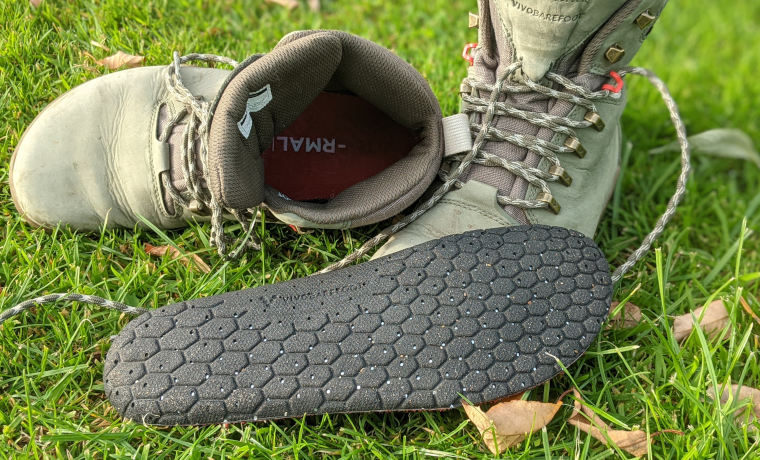
Features of barefoot boots or shoes for hiking
All good barefoot hiking shoes or boots should include these four basic design features:
- Lightweight design
- Wide, not tapering, toe box, allowing toes to splay and move naturally for better balance and comfort
- Flexible sole which folds or bends easily, allowing toes to move and bend over rocks and bumpy terrain etc
- Thinner soles which are completely flat, giving improved ground-feel and manoeuvrability
The best minimalist hiking boots and shoes in 2023
Now you know what to look out for, let’s check out some of the best minimalist hiking boots available at the moment.
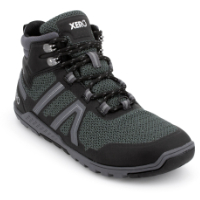
Xero Shoes Xcursion Fusion WP Hiking Boots
Colorado-based Xero shoes have been making barefoot-style shoes since 2009.The Xcursion Fusion WP is a good looking over-the-ankle hiking boot with a wide toe box. Fully waterproof, vegan-friendly and with flexible rubber soles, the 3.5mm lugs provide natural feel without loss of grip or traction for all terrain walking. The boots are lightweight yet strong with reinforced toe caps for added protection on rocky trails, with a handy removable 2mm insole so you can mix up the amount of ground-feel you prefer. Adjustable midfoot straps allow personalisation for security and relaxed fit, and built-in gaitor hooks are a useful addition. Xero recommend buying a half size larger than your standard boots.
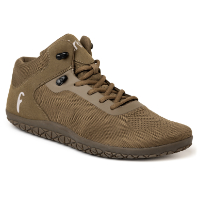
Freet Kidepo
Freet – I should have copyrighted my tagline freedom for feet!! – are a UK-based footwear company making barefoot and Japanese-style split-toe shoes since 2011. The Kidepo is a toes-together lightweight multi-activity performance bootee with vegan credentials and innovatively made from recycled coffee grounds! Mid-height and unlined, this men’s barefoot might work as a unisex shoe too. It is best for 3-season light trail running, hiking, gym, sports and casual day wear in warmer conditions. Breathable and quick drying for use with or without socks, there’s a separate waterproof sock available for use in cold or wet conditions. Additionally the bootees are hand washable. The forefoot is asymetric and with roomy toe box plus zero-drop sole, a removable insole completes the extra shock absorption if required. Freet recommend your usual EU size for this style or possibly a size larger.

Vivobarefoot Primus Trail Knit FG
With a 100-day free returns trial period, these high performance, vegan style Vivobarefoot hiking shoes are a classic barefoot design and fit – foot-shaped with a comfortable wide toe box and thin, flexible soles for natural movement. Sneaker-like good looks make them great for getting back to nature while hiking, running as well as round town. Sticky rubber, firm soles are suitable for multi terrain use with 4mm lugs giving good grip and freedom on rocky, rough, wet and dry trails. Made with recycled, renewable natural materials, Vivo recycle worn shoes too. Don’t forget the online size checker tool.
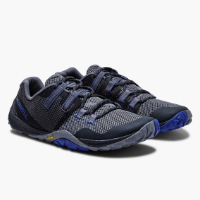
Merrell Trail Glove 6 Eco
The Trail Glove 6 Eco is the latest version in this style of Merrell minimalist hiking shoe suitable for light trail running with minimum cushioning. It’s an excellent transition shoe when moving to barefoot styles. Mimicking the shape of your feet, this is a lightweight trail shoe made from predominantly recycled materials. EVA foam insoles made from algal biomass offer comfort and cushion while a rock plate protects feet from underfoot debris. The shoe is ankle-height and fastens up with a 100% recycled shoelace. Mesh uppers and linings are breathable. Compared to previous iterations of the Glove Eco you may want to go a ½ size larger.
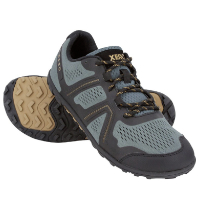
Xero Shoes Mesa Trail Shoes
Another great pair of trail shoes from Xero, the creators of the MOVEMENT Movement which aims to help get people moving and exercising more naturally. The Mesa Trail shoe is best for light trail running and casual everyday use, a snazzy trail shoe with spacious toe boxes. Zero-drop soles have 3.5mm lugs for incredible grip and durability for the genre. Quick-drying breathable mesh upper, non waterproof. Xero offer a 5,000 mile sole warranty on this style, and they recommend buying a half size larger than your usual.
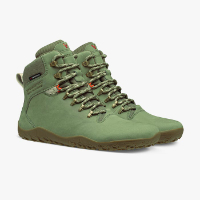
Vivobarefoot Tracker ii FG Hiking Boots
With all the above-mentioned Vivobarefoot guarantees as standard, the Tracker ii FG is a hard-wearing, hard-working, lightweight hiking boot. It’s the barefoot hiking boot I currently wear for mid-altitude trails, it is ankle-height and waterproof, with some great eco-credentials including part-reused and recycled materials. Whilst it’s not vegan, the soft wildhide outer is sourced from small, free-range farms so it still soothes the soul environmentally! 4mm lugs on the sticky rubber soles maximise ground feel and grip on most terrains including wet, dry, rocky and firm while a textured arch provides zonal grip for excellent technical trail movement. There’s also a removable thermal insole which uses NASA-developed heat reflective foil technology. I can definitely confirm toasty feet though I’ve not used them in snow as yet. Definitely use the size checker as mine are a size larger than my standard boots.
For more information read my full review of the Vivobarefoot Tracker ii FG Hiking Boots.



